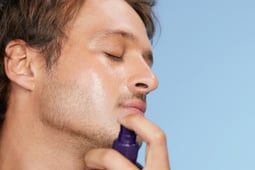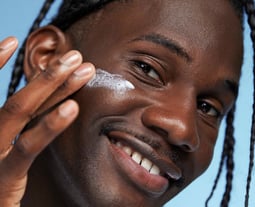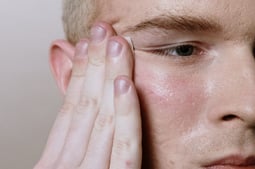

We help you take care of your dry skin.
If you’ve ever been skiing, you’re probably familiar with the feeling of skin tightness. However this isn’t a condition reserved to wintery slopes; it is also the consequence of dry skin, a more permanent problem. Dry skin isn’t as supple and soft and with time may become dull, coarse, and even cracked.
Where does dry skin come from?
There are multiple reasons skin becomes dry. Some of the main causes are climate-related: low temperatures, excessive exposure to sunshine, humidity, and even the wind can induce skin dryness. Medication and cleansing soaps can also have this effect. Certain deficiencies (most notably lipids), or genetic defects can also explain the condition.
For example, some skin types have a natural tendency to go dry quickly. This is the case for matte and black skins, that don’t retain water as well in mild and dry climates, and are therefore more subject to insufficiency, and require regular hydration.
Other types of dry skin, such as eczema, are environment- or stress-related. There has been a strong increase of these conditions over the past decades due to new hygiene and dietary habits. If this is something you are suffering from, we’re not saying you should run off into the woods and live as a hermit. We do recommend you take an appointment with a dermatologist, however.
What should be avoided
While it is tempting to use soap to wash your face, it would amount to taking unnecessary risks. When cleaning your face, soap removes the hydrolipidic film, one of your face’s protective layers. With no moisturising agents to counter this action, you are left with your skin feeling tight and coarse.
Contrary to popular belief, water alone will not moisturise dry skin. Some cities’ waters are very hard on the skin. This is the case in Paris, for example. The high levels of calcium in the water don’t make it dangerous to drink, but can be unhealthy for your skin. Calcium creates a thin layer over your skin, which dries it out, leading to rashes and even skin peeling. If you have dry skin, you should completely forgo washing with water and soap, and rather use products that will moisturise your skin. You should also look into having a shower filter installed, as it will purify the water.
How to take care of dry skin
Dry skin on the Face
First step: gently clean your face
Using a cleanser is absolutely essential. Make sure it is gentle and creamy so as to not make the situation any worse. Some ingredients have healing qualities: aloe vera, in particular, is popular for its effective moisturising power on dry skin. Cleansers with glycerin, such as ours, are especially useful. Hisrich formula cleans and moisturises the skin, and is therefore ideal for dry skin.
Second step: moisturise your skin to nourish and repair it
You should also include a strong moisturiser in your daily grooming regimen. Make sure the products you choose are nourishing as well as strengthen the skin’s barrier. Some ingredients, such as cranberry oil or glycerin are particularly efficient when dealing with dry skin, and enable intense moisturising.
Third step: light exfoliation to unclog and remove dead skin cells
Once to twice a week, use your usual cleanser with a Konjac and Binchotan sponge. It will unclog your pores and, more importantly, remove dead skin cells, one of dry skin’s many symptoms. Choose a very gentle cleanser that will not be too hard on your skin. After all, the aim isn’t to replace dead skin cells by rashes all over your face.
Fourth step: If your skin is still dry after steps 1 to 3, start using a night cream
For cases of resistant or recurring dry skin we recommend resorting to alpha hydroxy acids (such as glycolic acid). These acids, often found in night creams such as our Rich, induce skin peeling and a subsequent cellular renewal, which strengthens the skin’s barrier. Next time you see AHA on grooming products, do not mistake it for a reference to a Norwegian pop band, it is the universal way of indicating the presence of alpha hydroxy acids. Pretty practical, right?
Dry skin on the body
Dry skin isn’t restricted to the face only. Your body can also experience this problem, and more specifically, its extremities (elbows, hands, knees).
First step: choose a soap that will not dry your skin
As is the case for your face, traditional soaps are out of the question, and should be replaced with the cleansing and moisturising kind.
Second step: moisturise your skin with nourishing creams
Following cleansing with adequate products, we recommend thorough moisturising of the driest areas of your body with Shea butter or coconut oil-based nourishing creams.
Third step: repair the driest skin
Because they are so frequently washed throughout the day, hands are among the body parts most subject to limestone- or soap-induced skin dryness. Applying body moisturising cream can help soften and repair them. Think of your co-workers. Once they start shaking your hand they’ll never want to let go of it and will be ready to listen to you for hours. This could prove to be particularly useful next time you have something to negotiate.
While some prefer white wine to be dry, there’s really no debate when it comes to skin, which is always 100% better when perfectly moisturised. If you follow our above recommendations, you’ll never be left high and dry.










